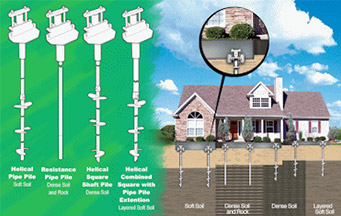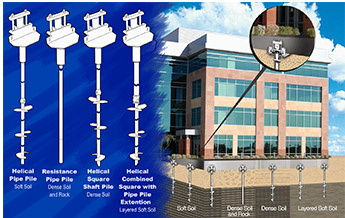Foundation repair is required for new or existing construction for reinforcement. Additional support is necessary when the area beneath the foundation is weak or has a possibility of being weakened in the future. Additionally, foundation settlement problems and settlement house movement is relatively common. For this reason, reinforcement is necessary to support and stabilize the building.
Foundation distress and building settlement can occur for a number of reasons. Poor drainage, collapsible or sensitive soils, and extreme drought, among other reasons, can undermine a structure’s foundation or cause the soils supporting it to shrink. This will cause the structure to settle and may cause foundation damage. This is especially true when the settlement is uneven. Examples of this are chimneys where the load is concentrated, and in locations where the foundation is discontinuous, such as at the interface between a slab-on-grade garage and a home with a full basement.
In cases where foundation distress is likely or has already occurred, a helical pile repair program can prevent or halt the structural damage that may occur. In some cases, foundation underpinning repair can raise the foundation back to it’s pre-settlement elevation.
Foundation Settlement: What are the Signs
- Vertical Cracks in Foundation
- Cracks around Door/Window Frames
- Cracks in Exterior Stucco
- Chimney Tilting or Cracked
- Cracks in Drywall
Foundation Settlement: How it Happens
- Shrinking Soil, due to Drought
- Heavy Rain and Flooding
- Poor Plumbing or Leaks
- Improperly Compacted Soil
Helical Piles for Foundation Repair
Foundation distress and building settlement can occur for a number of different reasons. When the soil either expands or shrinks, your foundation will heave or settle, respectively. In cases where foundation distress is likely or has already occurred, a helical pile repair program can be implemented in order to prevent or halt the structural damage that may occur and, in some cases, raise the foundation back to its pre-settlement elevation. Unlike other pile types, helical piles are installed with no vibration, which allows helical piles to be installed directly adjacent to a structure. In addition to being vibration free helical piles offer many advantages over traditional piles.
Vibration-Free Helical Piles
- Can be installed directly adjacent to neighboring structures
- Limited access installations
- High productivity rate
- Immediate loading
- No spoils
- Year round installation
- Predictable and reliable performance
- Installed with a variety of lightweight equipment
- Single pile capacities up to 105,000 lbs.


